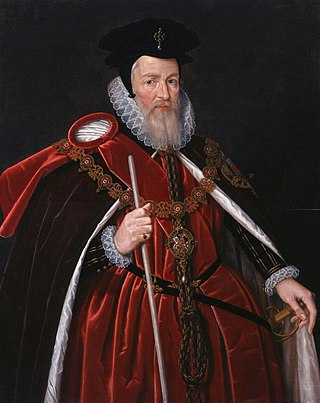
William Cecil, 1st Baron Burghley was an English statesman, the chief adviser of Queen Elizabeth I for most of her reign, twice Secretary of State and Lord High Treasurer from 1572. In his description in the Encyclopædia Britannica Eleventh Edition, Albert Pollard wrote, "From 1558 for forty years the biography of Cecil is almost indistinguishable from that of Elizabeth and from the history of England."

Robert Cecil, 1st Earl of Salisbury, was an English statesman noted for his direction of the government during the Union of the Crowns, as Tudor England gave way to Stuart rule (1603). Lord Salisbury served as the Secretary of State of England (1596–1612) and Lord High Treasurer (1608–1612), succeeding his father as Queen Elizabeth I's Lord Privy Seal and remaining in power during the first nine years of King James I's reign until his own death.

Sir William Chambers was a Swedish-Scottish architect, based in London. Among his best-known works are Somerset House, and the pagoda at Kew. Chambers was a founder member of the Royal Academy.

Inigo Jones was the first significant architect in England and Wales in the early modern period, and the first to employ Vitruvian rules of proportion and symmetry in his buildings. As the most notable architect in England and Wales, Jones was the first person to introduce the classical architecture of Rome and the Italian Renaissance to Britain. He left his mark on London by his design of single buildings, such as the Queen's House which is the first building in England designed in a pure classical style, and the Banqueting House, Whitehall, as well as the layout for Covent Garden square which became a model for future developments in the West End. He made major contributions to stage design by his work as theatrical designer for several dozen masques, most by royal command and many in collaboration with Ben Jonson.
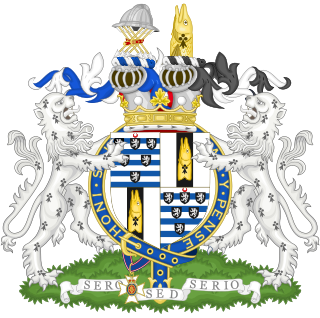
Marquess of Salisbury is a title in the Peerage of Great Britain. It was created in 1789 for the 7th Earl of Salisbury. Most of the holders of the title have been prominent in British political life over the last two centuries, particularly the 3rd Marquess, who served three times as Prime Minister in the late 19th and early 20th centuries.

Strand is a major thoroughfare in the City of Westminster, Central London. The street, which is part of London's West End theatreland, runs just over 3⁄4 mile (1,200 m) from Trafalgar Square eastwards to Temple Bar, where the road becomes Fleet Street in the City of London, and is part of the A4, a main road running west from inner London.

Marquess of Exeter is a title that has been created twice, once in the Peerage of England and once in the Peerage of the United Kingdom. The first creation came in the Peerage of England in 1525 for Henry Courtenay, 2nd Earl of Devon. For more information on this creation, which was forfeited in 1538, see Earl of Devon.
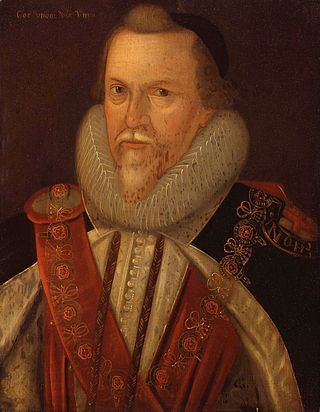
Thomas Cecil, 1st Earl of Exeter, KG, known as Lord Burghley from 1598 to 1605, was an English politician, courtier and soldier.
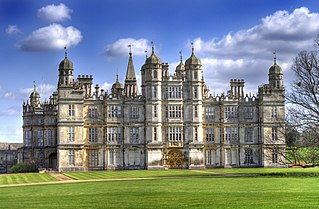
Burghley House is a grand sixteenth-century English country house near Stamford, Lincolnshire. It is a leading example of the Elizabethan prodigy house, built and still lived in by the Cecil family. The exterior largely retains its Elizabethan appearance, but most of the interiors date from remodellings before 1800. The house is open to the public on a seasonal basis and displays a circuit of grand and richly furnished state apartments. Its park was laid out by Capability Brown.

Exeter Hall was a large public meeting place on the north side of the Strand in central London, opposite where the Savoy Hotel now stands. From 1831 until 1907 Exeter Hall was the venue for many great gatherings by promoters of human betterment, most notably the anti-slavery movement.
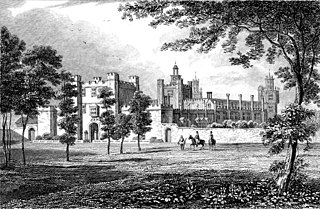
Theobalds House in the parish of Cheshunt in the English county of Hertfordshire, north of London, was a significant stately home and (later) royal palace of the 16th and early 17th centuries.

The King's Manor is a Grade I listed building in York, England, and is part of the University of York. It lies on Exhibition Square, in the city centre.

The Exeter Exchange was a building on the north side of the Strand in London, with an arcade extending partway across the carriageway. It is most famous for the menagerie that occupied its upper floors for over fifty years, from 1773 until the building was demolished in 1829.
Simon Basil was an English surveyor or architect, who held the post of Surveyor of the King's Works, 1606-15.

The Hotel Cecil was a grand hotel built 1890–96 between the Thames Embankment and the Strand in London, England. It was named after Cecil House, a mansion belonging to the Cecil family, which occupied the site in the 17th century. The hotel was largely demolished in 1930, and Shell Mex House now stands on its site.
Wimbledon manor house; the residence of the lord of the manor, was an English country house at Wimbledon, Surrey, now part of Greater London. The manor house was over the centuries exploded, burnt and several times demolished. The first known manor house, The Old Rectory was built around 1500 still stands as a private home, despite very nearly falling into a state beyond repair, in the 19th century. The ambitious later Elizabethan prodigy house, Wimbledon Palace, was "a house of the first importance" according to Sir John Summerson, and is now demolished.

In British usage, the term townhouse originally referred to the town or city residence, in practice normally in Westminster, near the seat of the monarch, of a member of the nobility or gentry, as opposed to their country seat, generally known as a country house or, colloquially, for the larger ones, stately home. The grandest of the London townhouses were stand-alone buildings, but many were terraced buildings.
This is a list of the etymology of street names in the London district of Covent Garden. Covent Garden has no formally defined boundaries – those utilised here are: Shaftesbury Avenue to the north-west, New Oxford Street and High Holborn to the north, Kingsway and the western half of the Aldwych semi-circle to the east, Strand to the south and Charing Cross Road to the west.
William Pymme was a landowner in Edmonton, now in London, a member of the Pymme family who had been granted land by Edward II in the 14th century.
Bedford House also called Russell House was the Elizabethan and Jacobean London home of the Russell family, Earls of Bedford, situated on the site of the present Southampton Street on the north side of the Strand. It was demolished in 1704 after the family had relocated to Bloomsbury.















